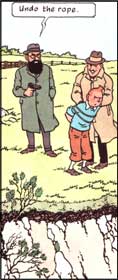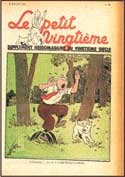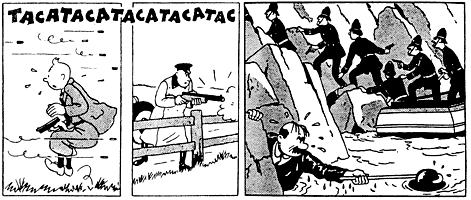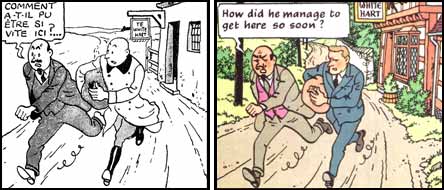History of The Black Island

- Image © Hergé/Moulinsart.
I couldn't believe it! Tintin had been captured by a couple of villains and taken (via a beautifully drawn snazzy claret Jaguar) to the white cliffs on the south-east coast of England, where he was held at gun-point and ordered to jump to his death. Despite it only being on page 8 of The Black Island, I could see no way out for the boy reporter from Brussels, and imagined that the next page would herald his last appearance as he fell to the rocky beach below.
Well, this was 1976, and I was seven years old, but whenever I re-read the book and reach this scene, I have vivid memories of my feelings at the time. The Black Island was the first Tintin book I encountered, it being a Christmas present from my mother, and I was captivated by the pace, the plot and the amazing detail that went into the accompanying graphics. I was astounded that there could be so much to a comic, my only other experiences being those provided by my weekly dose of The Dandy, or whatever else took my fancy that Friday on the W.H Smith news-stand. It never occurred to me that Tintin was any other nationality than British (I didn't notice the train Tintin boards on page 2 is travelleing from Koln to London, via Bruxelles), or that it was pretty much impossible for a seven year old boy to have such adventures (let alone hold down a job as a reporter!). I soon discovered however, that as I advanced in age each year, so too did Tintin1.
All this is a giant's leap in time from the story's origins, however, and the beginning of a very interesting history for this absolutely classic comic strip adventure. The book you can buy now in nearly any English book shop, courtesy of Methuen & Co, is quite different from the original strip that first saw print in 'Le Petit Vingtième' between April 1937 and June 1938 - almost sixty years ago!
- Le Petit Vingtième No. 29, July 1937.

- Image © Hergé/Moulinsart.
'Le Petit Vingtième' was subtitled 'the weekly supplement of the 'Vingtième Siecle' (Twentieth Century), a 'Newspaper for Doctrine and Information' which was edited by the Abbé Norbert Wallez. He created the supplement as a vehicle to exert his moralistic Catholic philosophy onto the younger generation of Belgium2, and chose as its editor (under his direction, of course) the then illustrator for the women's pages of 'Vingtième Siecle', a certain Georges Remi, who signed his work 'Hergé'. This was November 1928, and after two months of less successful comic strips, Tintin made his first appearance in the pages of the magazine, which is where he would stay until the war closed the paper down for good in 1940. These early adventures took the boy reporter to the Soviet Union, the Belgian Congo, America, India, China, and South America, before bringing him to the shores of Great Britain in 1937, the setting for Tintin's seventh adventure, The Black Island. Throughout these stories, Hergé's storytelling skills slowly improved, as did his drawing, of course, and he gradually gained more independence from the Abbé Wallez's influence over where Tintin should go3.
What were the events that pushed Tintin in the direction of the British Isles, and his subsequent adventure there? Georges Remi had made a brief visit, before Tintin had even been created, and perhaps as a result, he did harbour a fondness for the 'green and pleasant land'. One of his early encounters with the comic strip medium was through a British paper from during the First World War, 'The Rainbow', and by the time he became something of a rover in the late 60's and early 70's and had visited England again, he said of it, 'I like the English style of life. I feel more at home here in London than I do in Paris.'4 Certainly in 1937, England probably did seem green and definitely more pleasant than Belgium, which was uncomfortably close to Germany and the rise of the leader of the National Socialist Party, Adolph Hitler, with his recently fused Rome-Berlin Axis agreement and the worrying Anti-Comintern Pact. The realisation of such international concerns could have resulted in the creation of the book's main villain, Doctor Müller, giving us a glimpse of Hergé's allegiance in the matter. Apart from this, such political interests were reserved for Tintin's following adventure (King Ottokar's Sceptre5) when international events in Europe were really hotting up, and generally leaving the Black Island to exist as a very fine mystery adventure. But there were other topical themes of the 1930's that were soaked into the structure more fully. Organised forgery was a big problem for the law enforcement agencies of the world, as technology advanced and the aeroplane came into more common use, allowing greater distribution of illegally printed bank notes. Also, television was entering more and more homes - Britain being the leader in this area - the BBC in 1936 put out twelve hours of programming a week. Completing the components of the tale are the increase in sightings of the Loch Ness Monster during the decade, and the enormous success of the RKO film 'King Kong' just four years previously. The sum of these elements all come to fruition in a scene in the book where Tintin wanders around the Scottish castle of Craig Dhui - hide-out to a band of international forgers - whilst being stalked by the mysterious Beast of Kiltoch, a gorilla called Ranko, during which he comes across a television set which just happens to be showing the current aerobatic championships (the Thompson twins being the unwilling participants... and eventual winners!).
After the story had been serialised in 'Le Petit Vingtième', the Franco-Belgian company Casterman published the adventure in book form at the end of 1938, a task they had taken over from Wallez's 'Editions du Petit Vingtième' ever since 'Tintin In America'. The book comprised 124 black and white pages, plus the inclusion of four colour plates, showing Tintin and Snowy being chased by Müller's Great Dane, Tintin leaping onto Müller and Ivan's Rolls Royce (the claret Jaguar in the present-day version!), Tintin walking in his kilt through the village of Kiltoch, and the Thompson twins flying high above the Scottish countryside in their commandeered biplane. The book was coloured and set to Casterman's new restrictions of a 62-page format in a second edition during 1943, after 'The Shooting Star' (1942) became the first Tintin story to go straight into this format. The colour arose thanks to the publishing company's acquisition of a new offset machine, and the page count was due to the wartime paper shortages, though Hergé actually preferred this limitation, keeping it until the very last Tintin book in 19766. The new structure mainly just meant redesigning the page to accommodate four tiers (averaging 12 panels per page) instead of the previous three (averaging 6 panels per page) in the black and white books. Basically the colour edition was pretty much the same as the original as far as the actual drawing went.
- Two sequences from the 1938 book where guns were removed in 1966.

- Image © Hergé/Moulinsart.
Normally, besides reprints, this would would have been an end to the book's publishing history, but thanks to Tintin's British publisher, Methuen, The Black Island was to transgress this second phase7. The early 1960's saw Methuen's recently translated versions of the two Moon books ('Destination Moon' and 'Explorers On The Moon'), and 'The Calculus Affair', all books which showed off Hergé's high standards in research, technical precision and clear-line style. Of course, being basically 'Tintin In Britain', there was no doubt that the book was up for translation, but the publishers felt it was too inaccurate (originating in a simpler environment for the Hergé Studios) to be much of a success on 'home turf'. With Hergé himself too busy with his latest book, 'The Castafiore Emerald', but respecting the wishes of Methuen, he despatched his closest assistant of the period, Bob de Moor, to England, to conduct detailed research and bring back a full sketch book. The result, eventually published in 1966, is the edition available currently the world over, and is a pleasure to behold. This is not to say that the original version was fit for the scrap heap. The story did lose some of its charm and 'early Hitchcock8' atmosphere in the transformation, but the richness and attention to detail more than makes up for this loss, and with the new artwork, it proved the strength of the plot as it slotted in comfortably amongst the contemporary Tintin adventures9.
What did Bob de Moor achieve in the United Kingdom? He collected details of everything from the south-coast's white cliffs to car number plates, from 1960's fire engines and fashions to Sussex County Council road signs and English town skylines. He visited Scotland Yard, and in Edinburgh he was given a complete policeman's uniform, which differed in detail slightly from an English one. Even the horn-sound on the train is given the correct musical notation. Bateman's in Burwash, Sussex (the home of Rudyard Kipling, who died in 1936) became the model for Müller's house, Bishop's Stortford Station makes an appearance on page 30, Kiltoch was based on the village of Castlebay on the Isle of Barra, and the Black Island itself was the Isle of Arran featuring Lochranza Castle. All this data was taken back to Hergé's studios, where his skilled assistants (Bob, Jacques Martin and Roger Leloup) set about the graphic realisation of the new book... though Hergé drew all the characters himself, something he never let any of his assistants do. This was how he worked at the time, and it wasn't until 'Tintin and the Picaros' that he took things down a notch once more, with just himself and Bob de Moor working on the book.
'The Black Island' reveals a youthful Tintin, whose curiosity and 'roving reporter' persona always got the better of him as he followed up the slightest clue that might lead to adventure. Being shot on page 1 doesn't stop our hero from discharging himself from hospital and going to England to discover what it's all about! Compare this with the Tintin of later books, most notably 'Picaros' or '714', where he is merely carried along by events, almost an unwilling participant. In 'The Castafiore Emerald', all Tintin and Haddock want is a quiet time at Marlinspike Hall, but events dictate otherwise. As I said earlier, this was the book in production by Hergé Studios when the new Black Island was commissioned, and it featured two reporters from 'Paris Flash' who constantly pester Haddock - Christopher Willoughby-Drupe and Marco Rizotto, but take a closer look at page 61 of Black Island and you can see Willoughby-Drupe interviewing the old man of The Kiltoch Arms, and two panels later with his photographer, Rizotto, as part of the crowd that greets Tintin.
The Thompson twins make their fourth appearance in a Tintin book in Black Island, though at the time of the black and white version they had still not been named10, and come with all the traits of the early Thompson renditions, their squints of suspicion, bushier moustaches and slightly more menacing aura - fresh off of a Mack Sennet lot. In 1937, they were only just warming up to their famous catch phrase of 'to be precise...'. On page 2 of the 1966 book, Thomson says to Thompson, 'It all looks very fishy to me', and Thompson replies, 'To be precise: the whole thing looks like me, very fishy'. In 1937 they hadn't got quite that far - 'Bizarre affair, bizarre affair' says Thomson to his partner, who replies, 'To be precise, it is an affair... uh... an affair... bizarre.' Their names were of course revealed in the new version, as they were well known to Tintin readers by now as the Thompson twins. As far as The Black Island goes, this is one of their funniest books - in either version. Their bi-plane journey into Scotland is hilarious as they force the pilot to follow Tintin's into the air. 'You can cut out the... er... aerobatics' they tell him as they take off with a flourish, 'I'm s-s-sorry s-s-sir, I'm d-d-doing my b-best... it's the f-f-first time I've f-f-flown... I'm just the mechanic!'.
- Miller and Ivan escape from 'Ye White Hart' - far more authentic in the 1966 version.

- Image © Hergé/Moulinsart.
Most of the drawings are taken directly from the original as far as view point and angle are concerned, with perhaps just a frame here or there in the new version applying some of Hergé's new-found cinematic technique, but not to any great degree. Where the other books of the 60's were making fuller use of close-ups and angle variation, The Black Island is fairly faithful to the 1937 incarnation, not that this is noticeable. One thing that does give a hint to its earlier origins is the scene where Tintin suddenly produces a false beard out of nowhere to disguise himself, but Black Island in the main saw an end to this kind of slap-stick. There are less guns in the current version too, in keeping with reduced availability they afford in the U.K. In the original, the policemen who arrive at Craig-Dhui to arrest the gang of forgers all carry them, and earlier on, Ivan produces a machine gun and opens fire on Tintin, a scene that was cut out altogether in 1966. The 60's also saw the forged £1 notes turn into £5 notes, and the discovery of a television set in the castle to become less of a surprise.
British readers of Tintin are very fortunate to have had a consistently high quality of interpretation from Methuen's translators, Leslie Lonsdale-Cooper and Michael Turner (also a director of Methuen). They had a very close working relationship with Hergé himself, in fact they were great friends, and were in frequent consultation during their work. They pretty much anglicised all the books to a certain degree, which makes it less surprising to understand why so many British children believe Tintin to actually be British (though there are many obvious clues to say this is otherwise!). It is them we have to thank, in effect, for initiating the transformation of the rather quaint and naive 'L'Ile Noir' of 1937 into the spectacular 'location shooting' of the present day classic.
Notes
1 There is a wonderful letter that appeared in the Young Telegraph, June 1993; 'I'm a huge Tintin fan, but find it a bit weird that he can do just about anything! After all, he's only a boy, yet he can fly planes, drive cars and do motorbike stunts. How did he get his licence? I know it's only made up, but I do think he could give some children the wrong idea. ' Other gems along this line include the little girl who wrote to Hergé after seeing the animated version of 'Prisoners Of The Sun' (1969) complaining 'I don't like Captain Haddock at the cinema. He doesn't have the same voice as in the books!', or the boy from Zaire, who claimed that he would be perfect for the part of Tintin in a film.
2 Despite the fact that Wallez was the owner of a signed photo of Mussolini from 1924, he was by all accounts a kindly man who only wanted good to come to Society. It says a lot for him that he decided to include a comic strip in the supplement, one that combined humour, adventure and morality. Strict Catholicism was nothing too bizarre in 1920's Belgium, though he didn't fare too well once the Allies liberated Brussels in 1944, his trials labouring on into the 1950's - but perhaps it should also be remembered that he didn't prevent the blatantly anti-Nazi Tintin story, 'King Ottokar's Sceptre' from appearing in his children's supplement.
3 Pretty much confined to the U.S.S.R and the Congo, before Hergé settled on America for the third adventure, and managing to slip in the story he wanted to tell - that of the Native American Indian's plight, and casting a skeptical eye over U.S big business values.
4 Daily Mail, 5th September 1968.
5 See my article 'In Defense of Hergé', Vicious #4, February 1996 for more information on Hergé's wartime attitude and dilemma.
6 With the exception of the unfinished roughs of 'Tintin and Alph-Art' that were published in book form in 1986.
7 Notable exceptions include a recolouring of The Shooting Star and, again at the behest of Methuen, a replotting of the Land Of Black Gold, to do away with the complications of the British Palestine Mandate. The book was reset in Hergé's imaginary middle eastern 'Khemed' and was another adventure featuring Doctor Müller (He also briefly appears in 'The Red Sea Sharks' as Mull Pasha). Other books accommodated very minor changes as they were recoloured, quite a few due to American publishers who seemed very fragile to offense!
8 The story strongly echoes Hitchcock's 'The Thirty-Nine Steps', released in 1935.
9 'Flight 714' was appearing in 'Tintin Magazine' at the time, whilst 'The Crab With The Golden Claws' (original 1940, colour book 1943) received an English translation in the same year.
10 Their debut in 'Cigars Of The Pharaoh' merely saw them as Agents X33 and X33A.
Bibliography
- L'Ile Noir' by Hergé. Original version, Casterman 1987.
- The Black Island' by Hergé, Magnet 1981.
- Tintin, Hergé & His Creation by Harry Thompson, Sceptre 1992.
- Tintin And The World Of Hergé by Benoit Peeters, Methuen 1989.
- Hergé And Tintin Reporters by Philippe Goddin, Sundancer 1987.
- Entretiens Avec Hergé by Numa Sadoul, Casterman.
- America Discovers Tintin by T.F Mills, The Comics Journal #86, Nov. 1983.
- Halliwell's Film Guide' 11th edition, edited by John Walker, Harper Collins 1995.
- New Family Encyclopedia published by Lexicon Publications 1982.
Text © Garen Ewing. Used by permission.
